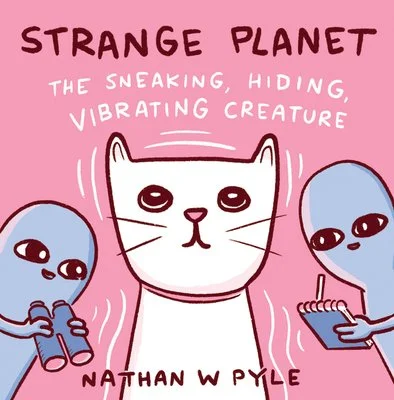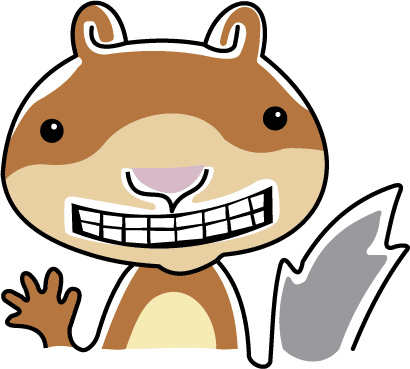On Laughing With Your Kids
Although I regularly find myself hilarious, neither of my sons agree. “No more jokes mummy” is a constant refrain. I’m often dismissed as not very fun. “Why do you listen to this boring music mummy,” my youngest said, as CBC played earnest folk songs in the background, “It’s not *funny*. Children love to laugh, and yet being in sync laughing together is so challenging. There are only so many fart jokes in my repertoire. And I sometimes find what they find funny on TV so sexist/racist or otherwise offensive I can barely stand it. But books are one place that adults and children can unite in laughing together – and what better feeling is there? Below are 3 books that have reliably gotten my kids and I to laugh together.
Strange Planet: The Sneaking, Hiding, Vibrating Creature
by Nathan W. Pyle
This book reminds us all of the arbitrary meaning and selection of words, meaning, and just life itself. It features two alien anthropologists of a sort, a seeming alien parent and child, who have decided to devote their day to studying a creature (a cat) prowling around their home – one “covered in thousands of soft fibers” with sharp “mouth stones.” As the book tells us, “One morning, when the nearest star was shining bright, I heard my lifegiver call to me, “Arise from your rest slab!” As the aliens eat breakfast together, a sustaining meal of “criss-cross floppers” with “sweet sauce” (waffles), the lifegiver tells their little alien that we are in for some science today. Passing over a pair of binoculars, the parent alien tells the child alien: “we will use these distant-observers to study its behaviors.” I love hearing the peels of laughter from my youngest son as I details the two aliens stalking the cat sneaking across “the foot fabric” (carpet) or climbing the “group-soft-seat with its deathblades” before walking “across a table and shoving a hydration cylinder off”. Partly, this book reveals how absurd life is. Why do we live with cats? Why do they randomly knock glasses of water off of desks? Why do we think that’s cute? This book is that magical combination of cultural anthropology (culture is indeed so arbitrary, as are the names we give things), demystifying how mystifying life really is, and also so *funny*. I can’t do it justice, nor can I recommend it highly enough. As my youngest son said to me after laughing at this book as I read it again and again. “Boy, do those aliens not understand anything.” It might be sleep deprivation, but truly, this struck me as so profound. How indeed can we ever know anyone or anything?
Yak and Dove
by Kyo Maclear, Illustrated by Esmé Shapiro
Friendship is so hard. I always think that the intensity of friendships and their highs and lows is a wrenching as any divorce between grownups. And yet, we don’t write songs about friendship and its struggles, or really model how to have conflict in friendships. Friendship remains a primary location where big love and big heartbreak occur. Enter Yak and Dove, illustrated by Esmé Shapiro and written by the brilliant Kyo Maclear. Yak and Dove love each other and hurt each other’s feelings and also just annoy the f*** out of each other. They are the best of frenemies. As Yak and Dove hang out, they discuss what they would be like if they were twins. “If we were twins, we could wear matching clothes. Oh, Dove! With matching hats and shoes?” Yes, said Yak, “And if we were twins, Dove, we would live in the same house.” And yet, even twins are different, and Yak and Dove struggle with this difference. “If we were twins, Yak, my feet would be cold when your feet were cold. And I would smile when you smile.” Yak and Dove can not help but wonder if this is really so true, and as they do, they start to wonder about their differences.
But, Yak, we are not alike.
You are large and I am small.
You have feathers and I have fur.
You can be a little too quiet.
You can be a little too loud!
..and so on, until they can’t take it anymore! “And you are smelly, Yak! And you are ill-mannered, Dove. You never share your chocolate! You make fun of my feet!” Understanding that we are different, and that this difference is not threatening but life-enhancing, seems to me one of the primary forms of my life's work. (Here’s looking at you, therapists who have tried and are trying to teach me this fact). I remember watching my youngest son at 3 eating a nectarine with his best friend. “Oh!” he said in wonder, “This nectarine is delicious. Try it!” “No,” his friend said: “I do not like nectarines.” And my youngest son said: “But it’s so delicious. Just try it. Try it, you’ll like it! TRY IT!” until the unbearable difference between them drove him to throw all the nectarines on the floor in sheer agony. At the time, I watched the fracas with an almost philosophical indulgence. How sweet, I thought. Until later that *same day* I urged my beloved partner to listen to a song I loved that reminded me of the two of us. Try it, you’ll love it, I said. It’s just like us. TRY IT!” Until she finally said: “It’s just not my style.” Yes, well. My youngest son loves this book. Yak and Dove are funny and different and #relatable. I love to see my son laugh when Yak and Dove make up. As Yak says “A best friend would not eat me,” telling Dove “I would never eat you, Dove. Not in a million years." And Dove says: "I would never eat you either, Yak.” And in that, they conclude: “Maybe we are a bit alike . . . after all.”
Scaredy Squirrel
by Mélanie Watt
I have previously mentioned this book as being useful for children struggling with anxiety. It’s particularly helpful for children who are struggling to try new things following the endless COVID lockdowns. It is also so, so funny to children and adults. Scaredy Squirrel is so neurotic! Scaredy Squirrel never leaves his nut tree. “He’d rather stay in his safe and familiar tree than risk venturing out into the unknown.” I hear you, Squirrel! No need for explanations, here. After all, as Scaredy Squirrel reminds us, the outside world contains “tarantulas, poison ivy, green Martians, killer bees, germs and sharks.” Ain’t that the truth. Yes, ok, maybe it does get a bit boring always staying in the nut tree because every day is the same, but this way “everything is predictable. All is under control.” Right on! One day, Sacredy Squirrel sees a (potentially killer) bee. Although he rushes for his safety kit, it falls out of the tree, and he leaps out after it. “But something incredible happens….he starts to glide. Scaredy Squirrel is no ordinary squirrel. He’s a flying squirrel!” All this excitement inspires Scaredy Squirrel. He mostly goes back to his old routine, after all, he’s still the same squirrel. But in addition to hanging out in his same old nut treat looking at the view and eating nuts, he now adds “jumping into the unknown” to his repertoire. It reminds me of teaching my kids to ride a bike. When my eldest son finally learned to ride, I jumped up and down and got so excited. “Don’t get so excited!” he told me. “I’m still going to have to ride my bike again.” And isn’t that it, in so many ways? Just because you did something so hard, doesn’t mean that you don’t have to keep doing it every fucking day. And my sons and I agree, somehow that’s funny! There’s just something so lifelike about life.
I hope these books make you and your kids laugh. “Even you have to take a break from talking about your feelings sometimes, don’t you?” my partner said to me. No, it seems I never do. But laughing with my kids while reading these books was so fun I hope it works for you folks too.


